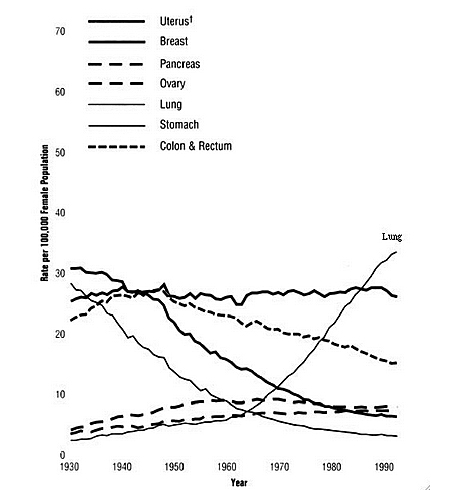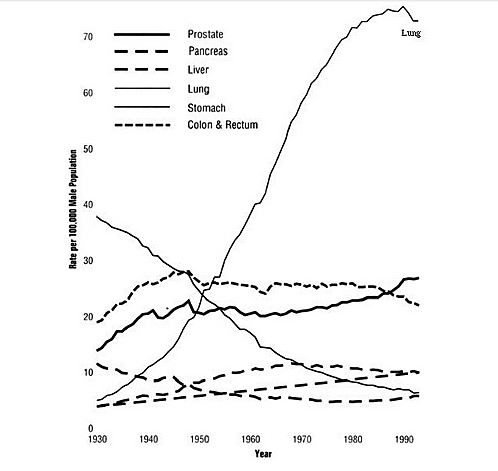
- Articles
The Nazi War on Tobacco and Cancer
I was recently asked to review The Nazi War on Cancer by Robert N. Proctor for Ideas on Liberty. What follows here is a more extended critique of this scholarly but deeply disturbing book.
Proctor, a professor of history of science at Penn State, thoroughly documents and describes in a good light what he calls “the lesser-known ‘flip side’ of fascism — the side that gave us struggles against smoking, campaigns for cleaner food and water, for exercise and preventive medicine.”(1) And indeed, he succeeds in documenting and presenting in comprehensive fashion the many medical accomplishments achieved by German scientists and physicians during the Nazi era (1933-1945) and the preceding year of the short-lived Weimar Republic. The “accomplishments” include the establishment of medical registries. While these registries initially assisted with legitimate public health functions, databases and their system of medical surveillance were later used for tracking purposes and implementing state sanctioned euthanasia. German physicians established the linkage of occupational diseases and cancer to environmental poisons, such as irradiation by uranium, radium, and radon (radiation poisoning and cancer); dust inhalations such as chromium (cancer of the lung), quartz (silica dust; silicosis), asbestos (asbestosis, lung cancer and mesotheliomas), etc.
Particularly interesting was the fact that German doctors discovered and established the link between aniline dyes and bladder cancer from the 1890s to the 1940s in I.G. Farben factory workers employed in the synthetic dye industry — one of the best documented and recognized occupational tumors during this period.(2)
The early Nazi zeal to eliminate occupational diseases shifted with the exigencies of the arms buildup and the need to increase production: “Efforts to eliminate illness turned into efforts to eliminate sick workers from the factory, the hospital. As one prominent Nazi doctor put it after the war, the physicians wanted “to eliminate sickness by eliminating the sick.” And in a chilly scenario of health care (industrial) policy in the making, evoking scenes of things to come in corporate socialism: “I.G. Farben’s Auschwitz plant,” writes Proctor, “put this into practice by never allowing more than 5 percent of its total workforce (all of whom were slave laborers) to be hospitalized at any given time. When the 5 percent figure was exceeded, selectees were sent to Birkenau and gassed.”(2)
Most dramatically, Proctor details how Nazi scientists were the first investigators to link and ultimately prove with elegant epidemiological and statistical studies that cigarette smoking causes lung cancer (at least two decades ahead of American and British scientists [one of whom, Sir Richard Doll, was knighted for this “discovery”]). Nazi officials moved aggressively in an all-out campaign against cigarette smoking in which tobacco was proclaimed “an enemy of the people” (Volksfeind).(3) In 1941, Hitler denounced tobacco as “one of man’s most dangerous poisons.”(3) It now appears, in fact, that the Nazi campaign against tobacco had beneficial, long-term effects for at least one subset of people — German women. However, in the post-war years as the economy improved and the reverberations of war subsided, Germans, like Americans, resumed smoking at high rates. In 1990, the annual lung cancer rate among German women was only 8 per 100,000 (for German men it was 49 per 100,000 and for American men it was 75 per 100,000). But because American women with the women’s liberation movement of the 1960s began to smoke heavily, their rate grew much higher to 32 per 100,000, much higher, in fact, 4 times higher, than the rate for German women. Proctor’s explanation: “Nazi paternalism, which discouraged, often with police force, women from smoking.” He estimates this policy may have prevented lung cancer death in some 20,000 German women. According to figures from the American Cancer Society (Figures 1 & 2), and to my surprise, I found that for 1990-1993 period, while American women held the perilous and death taking #1 position for lung and bronchus mortality figures (which now surpass breast cancer!), the German women held the more satisfactory 38th position for selected cancer sites in 48 countries.(4) In Europe, only Sweden had a lower lung cancer rate than Germany — except for Romania and Albania, which interestingly fought with the Germans in World War II (and may have been subjected to similar campaigns before and early during the war).
Figure 1
Age-Adjusted Cancer Death Rates*
Females by Site, United States, 1930-1993

Data Source: Vital Statistics of the United States, 1996 and American Cancer Society. From: Parker SL, Tong T, Bolden S, Wingo PA. Cancer statistics. 1997: CA Cancer J Clin 1997;47(1):14.
Figure 2
Age-Adjusted Cancer Death Rates
Males by Site, United States, 1930-1993

Of interest to medical historians and physicians is the epidemiology of stomach cancer during this century. The precipitous drop in the stomach cancer (death) rate — the #1 cancer killer from the turn of the century until the late 1940s to one of the lowest incidence today at 2 to 3 percent of all cancers — is one of the most propitious stories this century. Most likely, the drop in incidence and mortality was the result of better transportation and use of refrigeration (less spoiling) as well as less curing, salting, and smoking of meats in preservation and preparation of foods. Unfortunately, the drop in stomach cancer rates was accompanied by the concomitant rise in lung cancer rates that reached a crescendo for both men and women in the U.S. in the mid-1960s.
The connection between tobacco use with cancer of the lip, tongue, and nasopharynx was made in the early 18th century — in fact, the clue was there from the beginning for “Thomas Harriat, the English naturalist who brought pipe smoking to England from America, died of cancer of the lip in 1621.”
Nevertheless, the connection with lung cancer was not suspected until the work of the German scientists in the 20th century. This was due partly to the fact that lung cancer was relatively rare then, as well as to the fact it was easily mistaken for the Great White Death (tuberculosis). And so all through this time in the late 19th and early 20th century, the great neoplastic killer was stomach cancer. Lung cancer was not to rise in importance until the 1920s and 1930s after the usual 20 to 30 year latency following the mechanization of the tobacco industry for the mass production of cigarettes.
The campaign against tobacco is an eye opener not only because it recounts the forgotten scientific detail of these important breakthroughs, but also in my view, because of the similarities (and parallels) that can be drawn to the present campaign going on in America against the tobacco industry by our own government.* As the author states early in his Prologue: “The participation of doctors in Nazi racial crimes is disturbing, but it is equally disturbing that Nazi doctors and public health activists were also involved in what we today might regard as ‘progressive’ or even socially responsible — and that some of that work was a direct outgrowth of Nazi ideology.” Proctor believes that government interference in public health is acceptable, if it’s dictated by science. Unfortunately, he finds this view disturbing not because of matters of personal choice or civil liberties, but because he feels uneasy sharing that view with Nazis.
I agree with the author that many German physicians and scientists produced genuine medical research not only during the short 12-year Nazi era, but even before that, through the Wilhelmian and Weimar periods, and indeed, all through this time, Germany led the world in scientific achievements, particularly medical research (alongside their growing militarism). Nevertheless, these accomplishments must be taken within their ethical, moral, as well as historical context.(5) The author writes almost dispassionately, almost objectively, as the science historian he was trained to be.(6) Unfortunately, at least in this book, he lacks the analyzing eyes of the medical ethicist. As a trained neurosurgeon with a background in medical history and a more than passing interest in medical ethics, I don’t quite see the Nazi achievements from the same point of view.
The subject of “bioethics” and “medical ethics,” and their long term consequences to German society (or for that matter, ours) are not broached directly to the reader until the very end of the book and then it’s contained within two pages of text and four direct references out of an excess of 260 citations, whereby he reminds us “that the implications of Nazi Germany are not as obvious as some would like us to believe.” Furthermore, Proctor reproaches medical ethicists when he adds: “Bioethical discussions are full of facile identifications of Nazism for everything from abortion and nationalized medicine to doctor assisted suicide.”(7)
Although Proctor takes pains to let us know he does not condone Nazi atrocities, he suggests that authoritarian, strident public health policies, if “well intended,” should be implemented for the good of society and the betterment of the health of the nation — presumably at the expense of individual liberties and personal autonomy.
I side with medical ethicists and with those, not all of them libertarian souls as the author implies, who are troubled with further government authorities’ efforts in our time and country, who like their Nazi counterparts, are bent on protecting us from ourselves while robbing us of our personal autonomy and individual liberties.
It’s informative that even when the Nazis were protecting the German people from themselves with their public health policies, the effort must be underscored by the fact that they only cared to protect the Ubermensch, those fortunate enough to be members of the “German Aryan master race.” Public health and medical science were geared for producing a master race of workers who would work for the state until they died. The author writes, “The social policies ultimately favored by the government equated value of life with ability to work.”(8) And indeed, during the euthanasia program in which 200,000 Germans were put to death, those patients with illnesses who were capable of work were spared, like concentration camp inmates, until they could work no longer. Those who could not work were routinely put to death. Additionally, it must be noted the Nazis never banned tobacco because of the lessons of Prohibition in America (the Eighteenth Amendment was repealed in 1933 with the adoption of the Twenty-first Amendment to the U.S. Constitution) and because of the expediency of preserving the golden goose of tobacco taxes to which the Nazi regime, like any government, had become addicted. Killing that golden goose would have deprived them of an excess of one billion Reichsmarks for the 1937-1938 year, constituting one twelfth of the nation’s income!(9)
As we have seen, the goal of occupational medicine, one of the highest disciplines for the Nazis, was to make a “worker who would remain productive until retirement and then pass away shortly thereafter the aim was to reduce the difference between the age of retirement and the age of death — ideally to zero.”(10) And these were the lucky ones — the members of the master race. For the rest of the “undermen,” there was slavery, ghastly medical experimentation, and death in the abominable concentration camps.
And therein lies the danger of the unholy partnership of the medical profession and government planners — the perversion and subversion of the medical sciences and public health, and the rejection of the erstwhile sacrosanct individual patient-based ethics of Hippocrates for the new collectivist ethics of population-based medicine, whereby the health of the individual patient becomes subordinate to the collective good, as the Nazis put it “the health of the nation.” So parallels must be necessarily drawn with our present situation, as much as the author wants to avoid it.
Yes, there is “fascist danger inherent in any state-sponsored public or environmental health protection” in which physicians are enticed voluntarily or otherwise coerced to serve the state or the so-called greater good of society — rather than their individual patients. The parallels must necessarily be drawn for there is danger indeed lurking in our midst in our own United States, in our time — as in the areas of public health and the politicization of AIDS policy, mandatory vaccine programs, biased gun (control) research (and its dissemination in the medical journals), etc.
Despite the author’s reluctance to draw parallels, I nevertheless praise his scholarship and his courage to bring forth this knowledge in this era of political correctness and over-sensitive sensibilities. And in concluding, perhaps we should restate the obvious: For all their totalitarian power, the Nazi medical advances did not last — for they were buried in the ashes of their own destruction, the death of millions, and the disconsolate suffering of much of the remaining humanity of post-World War II.
In the end — as our society in general marches relentlessly down the path of incremental socialism and authoritarianism and the readers peruse the content and lessons of this book — the question Americans must consider is whether they prefer the dubious benefits of a regimented, oppressive society where as persons they will be protected as wards of the state as well as ultimately herded like sheep to their preordained destinies, over a free society. As for me, it’s obvious I prefer freedom; the freedom to act and the right to be sometimes wrong as long as I don’t violate the rights of others; the right to learn from my mistakes.
I strongly recommend this book to the readers of the Medical Sentinel with the aforementioned caveats, particularly medical history buffs, health care policy activists, and those in general interested in the perpetual struggle between the individual and the state.
Footnote
* For the AMA’s position and the public health establishment’s response to the tobacco threat in the U.S. during this time, see “Smoking Gun — Playing Politics with Tobacco and the Public’s Health” in The Serpent on the Staff: The Unhealthy Politics of the American Medical Association by Howard Wolinsky and Tom Brune, G.P. Putnam and Sons, New York, 1994, pp. 144-174. This book is difficult to obtain today, but our literary review appeared in Medical Sentinel 1996;1(2):36-37.
References
1. Proctor RN. The Nazi War on Cancer. Princeton, New Jersey, Princeton University Press, 1999, p. 11.
2. Ibid., p. 114-116.
3. Ibid., p. 199.
4. Parker SL, Tong T, Bolden S, Wingo PA. Cancer Statistics, 1997. CA Cancer J Clin 1997;47:5-27.
5. Proctor., op. cit., pp. 269-270.
6. Ibid., p. 265.
7. Ibid., p. 271.
8. Ibid., p. 118.
9. Ibid., p. 233.
10. Ibid., p. 119.
Written by Dr. Miguel Faria
Miguel A. Faria, Jr., M.D. is Editor-in-Chief of the Medical Sentinel, the official journal of the Association of American Physicians and Surgeons (AAPS), and author of Vandals at the Gates of Medicine (1995) and Medical Warrior: Fighting Corporate Socialized Medicine (Macon, Georgia, Hacienda Publishing, Inc., 1997).
This article was originally published in the Medical Sentinel and can be cited as: Faria MA. The Nazi War on Tobacco and Cancer. Medical Sentinel 2000;5(6):196-198. Available from: https://haciendapublishing.com/the-nazi-war-on-tobacco-and-cancer/.
Copyright ©2000 Miguel A. Faria, Jr., M.D.